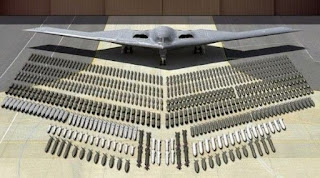Introduction:
In the ever-evolving landscape of military aviation, the B-21 Raider stands out as a revolutionary addition to the United States Air Force (USAF). As a highly advanced, stealthy, and long-range strategic bomber, the B-21 Raider is set to redefine air superiority for the 21st century. In this blog post, we will delve into the intricacies of this cutting-edge aircraft, exploring its design, capabilities, and impact on modern warfare.
Origins and Development:
The B-21 Raider is a next-generation strategic bomber that was developed to replace the aging B-1 Lancer and B-2 Spirit bombers. The program was initiated by the USAF to meet the challenges of future conflicts and ensure America's dominance in the skies. The Northrop Grumman Corporation was awarded the contract for the development of the B-21 Raider in 2015.
Stealth and Design:
Stealth technology is at the core of the B-21 Raider's design. Its sleek and angular shape, combined with advanced radar-absorbent materials, allows the aircraft to operate undetected deep within enemy territory. The exact details of its stealth capabilities are highly classified, but it is expected to possess a low radar cross-section and advanced electronic warfare systems to evade enemy defenses.
Advanced Avionics and Systems:
The B-21 Raider will be equipped with state-of-the-art avionics and systems to enhance its operational capabilities. These include advanced sensors, data fusion systems, and autonomous capabilities, enabling the aircraft to gather and process information rapidly in complex and hostile environments. The bomber will also incorporate advanced communication systems to facilitate real-time data sharing with other friendly forces.
Long-Range Strike Capabilities:
One of the primary strengths of the B-21 Raider is its long-range strike capabilities. With an impressive range and the ability to carry a significant payload, the bomber can strike targets deep within enemy territory without the need for forward bases. Its ability to penetrate heavily defended airspace makes it a formidable asset in both conventional and asymmetric warfare scenarios.
Future-Proofing and Adaptability:
The B-21 Raider is designed with adaptability in mind. Its modular design allows for future upgrades and integration of emerging technologies, ensuring its relevance and effectiveness for decades to come. The aircraft is expected to operate in conjunction with unmanned systems, leveraging their capabilities for enhanced situational awareness and mission execution.
Implications for Modern Warfare:
The introduction of the B-21 Raider into the USAF's arsenal will have profound implications for modern warfare. Its stealth capabilities and long-range strike capabilities will enable the USAF to project power globally, deter potential adversaries, and respond swiftly to emerging threats. The bomber's ability to operate in contested airspace will provide a significant advantage, supporting a range of military operations, including precision strikes, intelligence gathering, and long-duration surveillance.
Conclusion:
The B-21 Raider represents a significant leap forward in strategic aviation, embodying the latest advancements in stealth technology, avionics, and long-range strike capabilities. As the USAF's next-generation strategic bomber, it promises to reshape the future of air warfare. With its adaptability, stealth, and overwhelming firepower, the B-21 Raider ensures that the United States maintains its air superiority and remains at the forefront of military innovation for years to come.









0 Comments